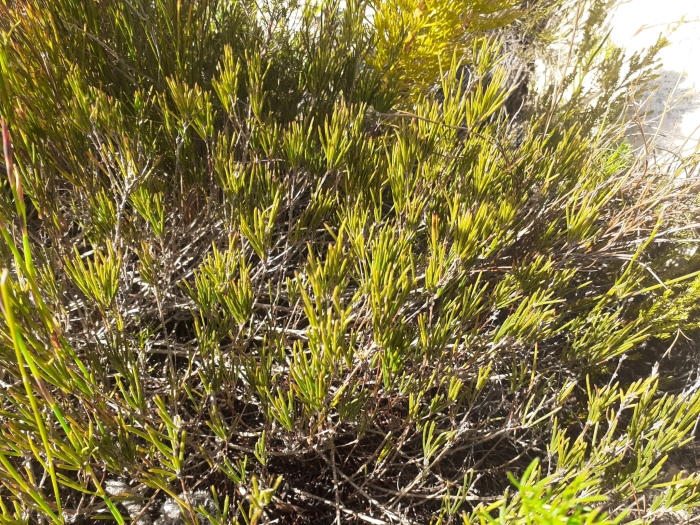Rooibos
(Aspalathus linearis)
Rooibos (Aspalathus linearis)
/
/

© Brian du Preez
CC BY-SA 4.0
Image By:
© Brian du Preez
Recorded By:
Copyright:
CC BY-SA 4.0
Copyright Notice:
Photo by: © Brian du Preez | License Type: CC BY-SA 4.0 | License URL: http://creativecommons.org/licenses/by-sa/4.0/ | Uploader: mr_fab | Publisher: iNaturalist |
























Estimated Native Range
Summary
Aspalathus linearis, commonly known as Rooibos, is a perennial shrub native to the fynbos biome of South Africa, specifically within the Cederberg region of the Western Cape province. It typically grows to a height of 1.5-2 meters and has needle-like leaves and yellow flowers that bloom in spring. The plant is adapted to the Mediterranean climate of its native range, with hot, dry summers and cool, wet winters. Rooibos is well-known for its use in producing a herbal tea, often referred to as rooibos or redbush tea, which is popular for its earthy flavor and numerous health benefits.
Rooibos is valued for its unique flavor, caffeine-free nature, and high levels of antioxidants. It is cultivated on a commercial scale and used to make various beverages, including traditional hot teas, lattes, cappuccinos, and iced teas. The leaves are harvested, fermented, and dried to create the distinctive red color and flavor of rooibos tea. In cultivation, Rooibos requires full sun, well-drained acidic soil, and can tolerate drought once established. It is not typically grown ornamentally but rather for its leaves, which are harvested for tea production. The plant is generally disease-resistant but can be affected by root rot if overwatered. It is not considered invasive outside its native range and is cultivated using sustainable farming practices to ensure the preservation of the fynbos ecosystem.CC BY-SA 4.0
Rooibos is valued for its unique flavor, caffeine-free nature, and high levels of antioxidants. It is cultivated on a commercial scale and used to make various beverages, including traditional hot teas, lattes, cappuccinos, and iced teas. The leaves are harvested, fermented, and dried to create the distinctive red color and flavor of rooibos tea. In cultivation, Rooibos requires full sun, well-drained acidic soil, and can tolerate drought once established. It is not typically grown ornamentally but rather for its leaves, which are harvested for tea production. The plant is generally disease-resistant but can be affected by root rot if overwatered. It is not considered invasive outside its native range and is cultivated using sustainable farming practices to ensure the preservation of the fynbos ecosystem.CC BY-SA 4.0
Plant Description
- Plant Type: Shrub
- Height: 3-6 feet
- Width: 2-3 feet
- Growth Rate: Moderate
- Flower Color: Yellow
- Flowering Season: Spring
- Leaf Retention: Evergreen
Growth Requirements
- Sun: Full Sun
- Water: Low
- Drainage: Medium, Fast
Common Uses
Drought Tolerant, Edible*Disclaimer: Easyscape's listed plant edibility is for informational use. Always verify the safety and proper identification of any plant before consumption., Low Maintenance, Showy Flowers
Natural Habitat
Endemic to the Cederberg region within the fynbos biome of South Africa
Other Names
Common Names: Red Tea, Rooibos-Tea, Red Bush
Scientific Names: , Aspalathus linearis, Achyronia tenuifolia, Aspalathus cognata, Aspalathus corymbosa, Aspalathus linearis subsp. linearis, Aspalathus linearis subsp. pinifolia, Aspalathus tenuifolia, Borbonia pinifolia, Genista contaminata
GBIF Accepted Name: